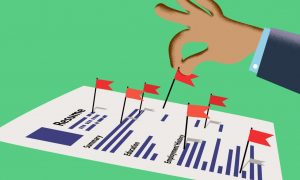Resumes are critical documents in your career-building path, but they’re a special focal point for many right now. That’s especially true if you’ve been laid off, otherwise lost your job, or if you’re simply wary about the future of your current employment.
As the coronavirus-related economic crisis continues to ripple through industries, even overturning how we work, people are naturally thinking about their ability to move around in the job market. As the unemployment rate remains high and companies rethink their own needs, an expertly tailored resume can be the linchpin that launches you into your next, better position. The abrupt loss of income only underlines the importance of a smartly written and designed resume.
“The fundamentals of a good resume haven’t changed because of COVID-19, but their importance has been magnified,” says Alex Twersky, co-founder of Resume Deli. “The pressure is there because more people are out of work, or fear being out of work due to cutbacks, and they’re anxious to have a good resume at the ready.”
While that anxiety can understandably lead some to rush updates to their resume, Twersky advises the opposite: “Take a breath and a little extra time to make sure your resume is tiptop. Once you’ve sent it out, you can’t recall it, so you need to make sure the resume adheres to solid basics: good structure, powerful language, clear positioning, professional layout, and most importantly, a focus on accomplishments. Show me, don’t tell me.”
Money talked to several career and resume experts about what you need to know as you completely revamp your resume right now. While the rules are much the same whether you’re still working or not, there are ways to signal your eagerness to work when you’re out of a job (don’t forget about LinkedIn!).
Think of yourself as a brand. Then target it.
Experts uniformly agree that a strong professional summary, at the top of your resume or LinkedIn profile, is a key way to sell yourself to a potential employer. (Wendi Weiner of the Writing Guru, who tends to work with executive-level clients, even suggests a “branding statement” to lead your resume before the summary.)
“Not a ton has changed. The resume is still about highlighting your most marketable value, experience, and skill sets. But I do see job seekers thinking more broadly about the types of roles they’d consider—particularly if facing job loss,” notes Dana Leavy-Detrick, managing director of Brooklyn Resume Studio.
While you might typically tailor a resume to climb up to the next step in your career, Leavy-Detrick notices more job seekers focusing on stability and lateral moves, or even willing to take a step down. To do that, you shouldn’t boast so much that you seem overqualified for the role.
Whatever the job you’re trying to get, you should think of yourself as a brand and cleverly aim that brand toward the particular position, experts agree. If you want to transition industries, “then the resume becomes more heavily focused on transferable skills and experience,” Leavy-Detrick says.
“Gear the resume toward the job you’re targeting, not necessarily the one you have or had,” she adds. “Highlight the skills and experience you possess that would help you make the leap towards the next level.”
While “transferable skills” can sound vague, chances are you have a number of coveted such abilities. Two of the top five skills companies are currently hiring for are soft skills (skills without specialized technical ability or certification), according to LinkedIn career expert Blair Heitmann: communication and problem solving.
“When a hiring manager looks at your LinkedIn profile, they’re also evaluating examples of how you demonstrate those soft skills such as leadership, teamwork, and prioritization. Be sure to weave these into your summary and experience sections, and include any professional content or work samples in your Featured section, which helps demonstrate your expertise and skills to not just recruiters, but also your broader community,” Heitmann says.
LinkedIn profiles thrive on search engine optimization (SEO), so when you tend to that virtual resume, think about common keywords from job applications you’re looking at that you can include. Likewise, “listing skills on your profile is key to showcasing your capabilities to recruiters and hiring managers. We’ve found that listing just five relevant skills increases your chances of being found in recruiter searches by 27 times,” Heitmann explains.
While those keywords can boost you on LinkedIn, somewhat counterintuitively, they can hurt you on the resume you send out to a hiring manager: “Make sure your summary isn’t too generic and rambling” on the page, Twersky coaches. “Avoid self-descriptors like ‘team player’ and ‘detail-oriented’ because they can apply to anyone rather than you specifically. Make sure your summary makes the strongest argument for who you are and what you do based on your specific level of expertise.”
Make that summary stronger by cutting any nod to what you hope to get out of a new job. “Your objective is to find a job, but your professional summary should resonate who you are as a professional and the high-caliber skill sets you have to offer. I like to think of the professional summary as an enticing introduction or roadmap to the novel about yourself,” Weiner says.
Highlight accomplishments, not tasks. Grab your brag sheet.
One of the most common pitfalls of weaker resumes, experts concur, is something you may not realize you’re doing: listing tasks, rather than achievements, in your work history.
“I find that a lot of professionals focus too much on job tasks and functions,” Weiner says. “The more effective thing to do is to fuse those important keywords (business development, client management, etc.) into your work experience section by showcasing them through the results, major contributions, and key projects you have worked on at various companies or organizations. This is the way to distinguish yourself among the hundreds of applicants applying for the same job.”
The emphasis on concrete accomplishments is subtle but can transform a lackluster resume.
“One important tip that I like to share with people is to not only outline what you did on a day-to-day basis in your previous roles, but to also spotlight the impact that you made on your business while you were there,” Heitmann says. “So instead of simply saying, ‘Implemented a marketing strategy,’ be more specific: ‘Implemented a marketing strategy that led to a 300% increase in customer leads.’”
A simple way to narrow down accomplishments, especially if past work experience can seem like a giant blur, is to “begin to create a brag sheet,” Weiner advises. “Think about your unique value in each role, three major projects you worked on in each role, and focus on both quantitative and qualitative achievements.”
Ditch the cute stuff. Stick to one or two pages.
Experts more or less have a consensus on a flexible resume format: Start with a professional summary (possibly with a tight branding statement above that to drive home your value in a sentence or two), tack on a short list of core competencies, transition to a professional experience section with bullet points of detail for each role (as you go back further, use less detail). Then wrap up with ancillary sections like education/training, technical skills, affiliations, community service, and certifications (less is more here).
Minimalism is not only a way to save a recruiter time, but it provides a “sleek look” that helps you immediately get noticed without fuss, Weiner says.
As for fuss: Unless you’re applying for a visual job in which your art direction and design acumen are central, cut out any unnecessary imagery or flashy visuals. “While they may make the resume stand out, they’ll simply detract from your overall message, and possibly make the resume less compliant with Applicant Tracking Systems (ATS),” Leavy-Detrick observes.
Too much or too little detail can be problematic, so start with a full picture you can cut down with simpler words and or by removing points that the prospective employer won’t find especially useful.
While a one-page resume will get points for brevity, don’t be afraid to go slightly beyond that if you’re at the midpoint or senior chapter of your career. But “avoid having a resume run longer than two pages. Any more than that, and your reader is likely to gloss over the information and miss key details,” Leavy-Detrick explains. “For the same reasons, don’t cram the resume onto one page if it doesn’t make sense to do so. I typically see people going onto two pages around the 8-10 year mark in their career.”
Be honest, but know your audience
Okay, so you lost your job. Maybe you were laid off, maybe you were furloughed in the midst of the coronavirus economic fallout, or perhaps you were just fired.
This is a touchy subject, especially on a resume before you’ve even met a hiring manager who can make the decision about your future. But it’s one that’s faced by millions, particular during this turbulent moment in the job market. People will be more understanding than you realize.
“Having a gap on your resume isn’t as big a red flag as it once was,” Leavy-Detrick says. “There are a lot of industries in which freelancing and contract work are the norm (film, entertainment, creative), and gaps between projects are typical.”
Still, experts agree that explicitly mentioning how a period of employment ended is not the job of a resume. “Be prepared to explain the gap in the interview, or if you can put a positive spin on it, address it in the cover letter,” Leavy-Detrick adds. “Even if you do choose to address the gap, keep it concise and avoid bringing up any negative aspects.” (Throwing your former employer under the bus, however difficult they were, is a big no-no.)
The digital ether might provide an unexpected source of hope. While LinkedIn amasses endless profiles, it’s started offering a new feature for those who want to make it clear they’re energetically looking for new employment.
“At the onset of the pandemic, we saw so many members reaching out to one another on LinkedIn, offering their advice and help,” Heitmann says. Inspired by that activity, the platform introduced the #OpentoWork photo frame to its community of 700 millions-plus professionals.
“When turned on, it lets anyone who sees your LinkedIn profile—whether it comes up in a search or on the feed—know that you’re looking, and help connect you to open jobs they know of. It’s been great to see how members are utilizing the tool and connecting with their professional community.”
The post Your Resume Probably Needs a Pandemic Makeover. Here’s Where to Start appeared first on Money and is written by Paul Schrodt
Original source: Money





